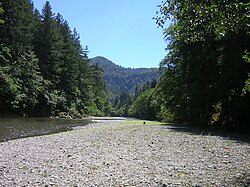Mattole

Mattole River in Humbodlt County
|
|
| Regions with significant populations | |
|---|---|
|
|
|
| Languages | |
| English, historically Mattole |
The Mattole, including the Bear River Indians, are a group of Native Americans in California. Their traditional lands were along the Mattole and Bear Rivers near Cape Mendocino in Humboldt County, California. A notable difference between the Mattole and other indigenous peoples of California is that the men traditionally had facial tattoos (on the forehead), while other local groups traditionally restricted facial tattooing to women.
Their Wailaki name was Tul'bush, meaning "foreigners." The Bear River Indians called themselves and the Mattole "Ni'ekeni'".
The Mattole spoke the Mattole language, an Athapaskan language that may have been closely related to that of their Eel River neighbors to the east. According to linguist Victor Golla, the last surviving person who could speak the Mattole language died in the 1950s.
Historically, the Mattole lived along the Mattole River in the valley of Humboldt County, northwestern California. The Mattole lived in the area for a few centuries, but carbon dating revealed that many native tribes have inhabited the land for over 6000 years. Earliest accounts say that the Mattole have been in the region of the Bear River tribe since the 16th century. From the mid-16th to the 19th centuries, the Mattole resided at the coast near the mouth of the river.
The Mattole were only permanent residents of a particular area through the winter months. For the most part, however, the Mattole people traveled in single family bands, traveling as necessary according to food abundance and better climate conditions—an easy feat with California's many microclimates.
Aboriginal Bear River villages included Tcalko', Chilsheck, Chilenche, Selsche'ech, Tlanko, Estakana, and Sehtla.
In the 1850s, Euro-American settlers started ranching and agricultural traditions on the land. This would inhibit contraction of disease and decrease the native Mattole tradition of relying on river resources. Post World War II: Logging of Douglas fir became an increased practice for this period of building construction and the tax value of standing trees rose as well. Since logging increased, more debris settled in the Mattole river, further damaging it.
...
Wikipedia
